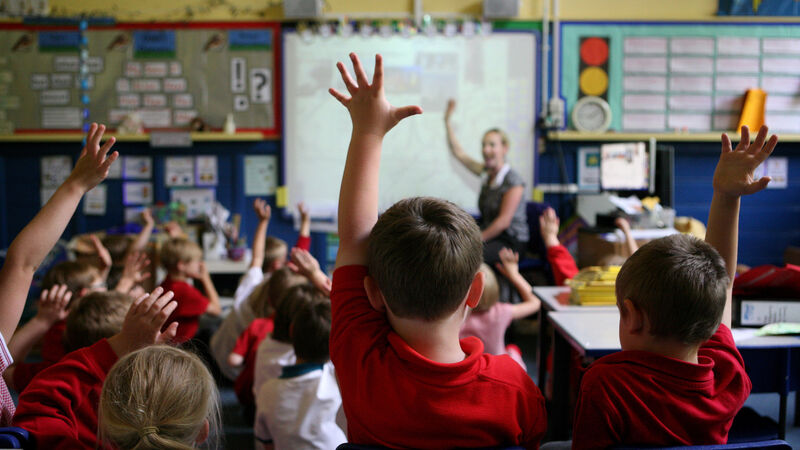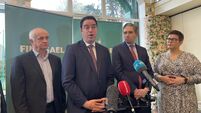Teachers fear poor facilities, class sizes, and stigma are holding back Deis schools

With one in four students now supported through the Deis programme, the new research makes a strong case for increased, targeted measures to address education inequalities. Stock picture: PA
Teachers working in disadvantaged schools have highlighted their concerns over poor classroom facilities, class sizes, persistent stigma, and a lack of transparency in resource allocation.
With one in four students now supported through the Delivering Equality of Opportunity in Schools (Deis) programme, new research makes a strong case for increased, targeted measures when it comes to addressing education inequalities.
Teachers also raised concerns that inconsistent supports for students transitioning from disadvantaged schools to higher and further education may be contributing to higher dropout rates.
Disadvantaged students experience the highest non-progression rate at college at 23% compared to just 12% among their more affluent counterparts.
The findings are included in new research commissioned by the Teachers’ Union of Ireland (TUI) and conducted by Tasc, the Think-tank for Action on Social Change.
In interviews with almost 230 teachers and 47 school leaders, the study found that class sizes in the Deis schools surveyed frequently match those in non-Deis schools.
This was despite the programme’s stated commitment to smaller classes.
Poor infrastructure was also a recurring theme, with 10% of teachers in Deis schools rating classroom facilities as “very poor” compared to just 2.8% of teachers in non-Deis schools.
Science labs and sports facilities were of particular concern, with 32.5% of teachers in Deis schools rating them as “poor” or “very poor”.
While some teachers felt that negative attitudes had diminished over time, persistent stigma was identified as a major issue. This included negative stereotypes such as assumptions that students are “low-achieving” or “non-academic”.
Teachers noted that this stigma not only impacted students but also extended to teachers, parents, and the wider community. Some teachers suggested these stereotypes were internalised by students, which in turn impacted their attitudes and behaviours towards learning.
Several teachers expressed the view that this stigma created a toxic culture “with some students seemingly resigning themselves to these low expectations”.
Some teachers believed that a school’s Deis designation could inadvertently attract students with behavioural difficulties and expressed concerns that school management sometimes used the school’s DEIS status as an excuse for student behavioural issues.
The challenge of managing large class sizes with diverse student needs was also highlighted by teachers taking part.
“Teachers felt stretched thin, unable to adequately support every student in the classroom.”
Some teachers also expressed concerns that by providing students with extensive free resources and support, Deis schools were “removing a degree of personal responsibility from students, which led to some students taking support for granted”.
One teacher told researchers: “It has developed a toxic culture in the school whereby the students themselves write themselves off before they have even begun, claiming themselves that they are Deis students and it’s a Deis school, so the expectations are automatically lower.”
Both teachers and management believed that greater autonomy for schools in allocating Deis funding would better address the specific needs of students. However, there was also a “prevalent sense of pessimism” among teachers about the effectiveness of current Deis funding, with many stating that they could not perceive any significant impact on student outcomes.
One teacher said: “I feel there is an awful lot of money being spent on extra help and sometimes it is so vague that really it is making no difference.”
Compared to teachers, school management expressed a more positive view of Deis targets and goals.

However, some management respondents did note that, despite the additional resources, they had not observed a significant improvement in student learning as a result of Deis status.
A few acknowledged the gap between the theoretical benefits of Deis support and its practical application, suggesting that, in some cases, Deis support was not translating into tangible improvements for both teachers and students.
TUI general secretary Michael Gillespie said the report makes clear that teachers in these schools find their roles personally rewarding, particularly in supporting vulnerable students.
Almost two thirds (62%) of teachers in Deis schools agreed that the programme improved access to higher education, while 73% saw enhanced access to further education, he added.
“However, it is of serious concern that most teachers believe class sizes are still too large, while the fact that 33% of respondents in Deis schools describe science labs and sports facilities as being ‘poor’ or ‘very poor’ is unacceptable for a country of our resources.
”In terms of the report’s recommendations, the introduction of a tiered funding model to match specific school needs would allow for greater autonomy, as no two school communities are the same," he added.
“The TUI has called for such further resourcing for a number of years, and in our interactions with the new minister, we will be urging that the achievements of the Deis programme are further built upon through additional, targeted investment.”
Sara Singleton, Tasc's head of public education & senior researcher for social inclusion, said persistent stigma attached to Deis schools remains one of the most prominent challenges.
“Negative stereotypes about students’ abilities, often rooted in assumptions of their socio-economic background, hinder both their academic progress and the professional esteem of their teachers. These perceptions affect student confidence, enrolment patterns, and public support for Deis initiatives.”
“Addressing this stigma through public awareness campaigns that celebrate the achievements of Deis schools, alongside better recognition of the contributions made by teachers in these settings, is essential to combat these misconceptions.”












